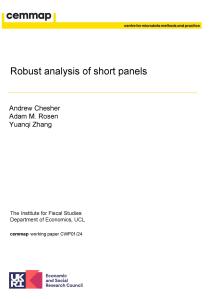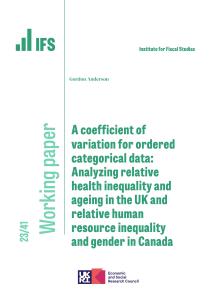This paper develops a new separability concept - latent separability. This is shown to provide a useful empirical and theoretical framework for investigating the grouping of goods and prices. It is a generalisation of weak separability in which groups are identified by specific exclusive goods but where other goods are allowed to enter more than one group. It is shown to be equivalent to weak separability in latent rather than purchased goods and provides a relationship between separability and household production theory. For the popular class of Linear, Almost Ideal and Translog demand models and their generalisations, the number of groups is shown to relate directly to an empirical rank condition. A detailed method for exploring the presence of latent separability is presented and applied to a long time series of household level consumption data for the UK.
Authors

CPP Co-Director
Richard is Co-Director of the Centre for the Microeconomic Analysis of Public Policy (CPP) and Senior Research Fellow at IFS.

Research Fellow Sciences Po and University College London
Jean-Marc is a Research Fellow of the IFS and a Professor of Economics at Sciences Po, Paris, and University College London.
Working Paper details
- DOI
- 10.1920/wp.ifs.1995.9509
- Publisher
- IFS
Suggested citation
Blundell, R and Robin, J. (1995). Latent separability: grouping goods without weak separability. London: IFS. Available at: https://ifs.org.uk/publications/latent-separability-grouping-goods-without-weak-separability (accessed: 26 April 2024).
More from IFS
Understand this issue

Gender norms, violence and adolescent girls’ trajectories: Evidence from India
24 October 2022

Public investment: what you need to know
25 April 2024

The £600 billion problem awaiting the next government
25 April 2024
Policy analysis

ABC of SV: Limited Information Likelihood Inference in Stochastic Volatility Jump-Diffusion Models
We develop novel methods for estimation and filtering of continuous-time models with stochastic volatility and jumps using so-called Approximate Bayesian Compu- tation which build likelihoods based on limited information.
12 August 2014

Assessing the economic benefits of education: reconciling microeconomic and macroeconomic approaches
This CAYT report discusses the strengths and limitations of several approaches to assessing the effect of education on productivity.
14 March 2013

Misreported schooling, multiple measures and returns to educational qualifications
We provide a number of contributions of policy, practical and methodological interest to the study of the returns to educational qualifications in the presence of misreporting.
1 February 2012
Academic research

Understanding Society: minimising selection biases in data collection using mobile apps
2 February 2024

Robust analysis of short panels
8 January 2024

A coefficient of variation for ordered categorical data: Analyzing relative health inequality and ageing in the UK and relative human resource inequality and gender in Canada
21 December 2023